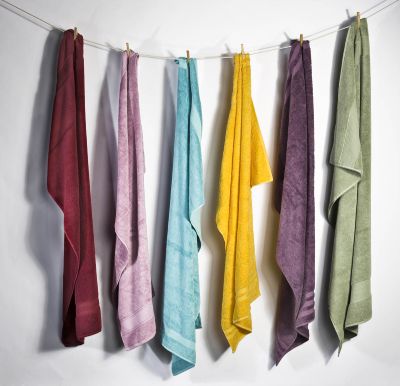Some dry facts about towels
When buying, higher costs don’t always mean higher quality

“How’d you like the towel?” I asked a guy in my household.
“It was a towel,” he said.
“But was it better than the one you used yesterday?” I persisted.
“I forget.”
In a lot of families, towels get no respect. If they suck up water, they’re considered good enough.
But, it turns out, there’s much more to making good choices than that.
Determined to help you get the most dry for your dollar, I tried out a half-dozen towels at prices ranging from $4 to $30 and talked to experts about what to look for.
I didn’t need a towel expert to tell me the single most important thing I found out on my shopping expedition: Never pay full price. Somebody, somewhere always is holding a sale. Or is about to.
One example: I was about to plunk down the full $40 for a thick Macy’s Hotel Collection towel, but when I complained about the steep price, the salesman tipped me that the store soon would hold a one-day sale. I waited and paid $29.99 – 25 percent off.
Higher cost does not always mean higher quality. Do you get what you pay for? Is a $40 towel four times better than one that costs $10?
“I seriously doubt it – if your primary purpose is to absorb water,” says E. Linwood Wright III, a 53-year veteran of the U.S. textile industry.
“It has little to do with price. People sell pretty expensive towels that are pretty bad,” adds Tom Muscalino, a former president of two U.S. bath and bedding companies who now sells his private bedding and towels directly through thomasleeltd.com.
Walk into the bath department of any large department store and you will see dozens of choices, from well-known designers (Ralph Lauren) to familiar brands (Cannon) to store brands (Macy’s).
It’s daunting. How’s a customer to choose?
“It’s incredibly confusing, and the poor consumer doesn’t have a prayer knowing what they’re getting into,” Muscalino says. “It’s impossible to tell by the labels.”
Just because the towels are tagged Egyptian, Turkish or bamboo doesn’t necessarily make them better than others.
Before you make big investments, make a small investment, Wright and Muscalino advise. Buy a single towel – even a hand towel – and test it at home before buying in quantity.
Look for drying power on wet skin, softness and whether it leaves gobs of lint in the dryer filter after repeated washings.
Color matters, and not just as a matchy-matchy décor issue. White or light is dryer, softer. Wright says a white towel is likely to be more absorbent.
“A dark or brightly colored towel, unless it’s painstakingly dyed, is going to feel stiffer and harsher after one or two launderings,” Muscalino says.
Size matters too. If you want to wrap and tuck after you dry off, pay attention to the measurements on the label and to shrinkage in your home testing. (Too small? Consider the larger, more expensive bath sheet.)
After washing, the length difference between the biggest and smallest towels in my test was close to 10 inches.
And remember who will use them. A cheap, smallish towel might be fine for small kids or ’tweens who will use them to wipe off their bikes. Luxe heftier models have a hotel spa feel that will impress your guests.